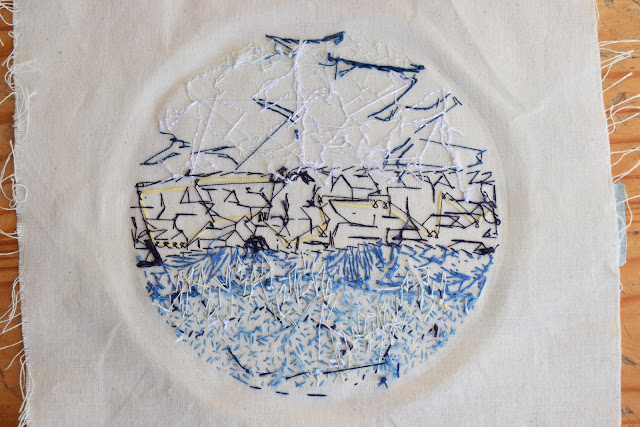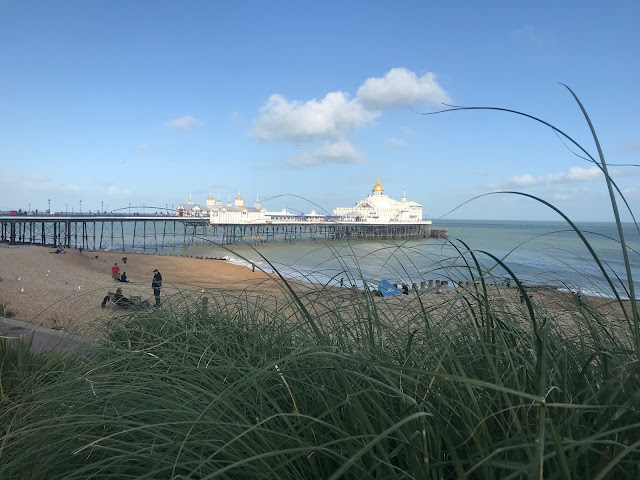I really enjoy working on commissions; they are all completely different and usually a challenge with various obstacles to overcome or wobble moments where I'm not sure that the fabrics I've chosen or stitches I've been working are going to end up looking like I want them to look like. (Or that whoever has commissioned it hates it at the end and it's a total disaster - but I try not to think about that one.)
For this piece I was sent various photos and also did a bit of research (thanks Google) on the place myself before starting. It's Brightling Church in Robertsbridge, East Sussex, England, and the pyramid mausoleum in the graveyard there of John 'Mad Jack' Fuller - not something you expect to see everyday in an English graveyard!! The additional requests for this commission were to include sheep as they are sometimes allowed in to the graveyard to graze and also to include Cornflowers somewhere within the piece.
It took me a while to get into stitching this piece I really wasn't sure on the composition between the church and the pyramid but I couldn't find any references or photographs taken from different angles to see how other positions might work. It also took a while to get the sizing and the perspective right but I think I got there in the end with a pinch of artistic license.
The sky layers were nice and simple as I wanted the weight of the work and the embroidery to be where the buildings are so the very top layer has a single strand back stitch following the chevron pattern, with single strand bullion knots at the top. The next layer has a single strand running stitch throughout the layer, edged with two strand bullion knots.
In all of the photos of the church there are trees behind the buildings so I wanted the first green layer to look almost fluffy with the different leaves. To achieve this I worked a double strand of seed stitch over the gorgeous mottled batik fabric and then tried to cluster the french knots at the top so that they added a bumpiness to the fabric edge like an unruly tree canopy.
The green fabric underneath this is almost a mirror of the above layer, but uses only one strand for the seed stitch and I've added a single strand vertical whip stitch which is now slightly hidden behind the fence and flowers but just gives it an additional texture to make it different and appear more grounded. Hopefully you can see what I mean.
It's amazing how much that simple fence did to enhance the perspective of this piece. It was the last thing to go in and hadn't been on my original list of things to add as you can barely see it in a lot of the photos, but the piece was looking so flat and the church slightly oddly positioned behind the pyramid that I thought I would give it a go and it immediately pushed the church back and made sense of the whole piece. (A slight 'phew' moment!)
The Cornflowers were stitched as tiny little star stitches in a bright vivid blue. They stand out from the piece, not least because there is nothing of that colour anywhere else in the scene so they pop out from the bottom. I haven't put too many in there though, they are just adding to the general melee of greenery and plant-life at the bottom. I quite like them for their quirkiness and decided to leave them as they were on their own, although my original intention was to add in bullion knot flowers as well on top of the other straight stitch stems. I'm glad I didn't as I think that would have been too much.
Around the majority of the gravestones I have added little fly stitch green stems and yellow daisies, with the yellow of the flowers being picked up in several layers throughout to give a continuous feel to the ground levels.
The sheep have been stitched in my tried and tested method of white french knots in various sizes and simple rough satin or straight stitches in black for the head and legs. Where the sheep have been cut off underneath the pyramid I have carried up the french knots a little bit but then decided that you could be looking at the back of the sheep or it could have its head down grazing so I haven't added heads or limbs back on to those where they have been cut off by the pyramid base.
For the pyramid itself I decided to use several different fabrics rather than keep it to the same one as I was worried about it becoming boring and samey - and you then losing the sense of it being a three dimensional shape.
I'm really pleased I went with different fabrics as it also gave me a chance to make one side slightly darker and heavier and I could play with different stitches. The brickwork patterned fabric side (right) was done first with the bricks edged in back stitch as per the pattern underneath and additional straight stitches were added in different colours to add texture where needed. The batik pattern on the opposite side was then texturised (I'm making that word up I think) with a super rough satin stitch (or collection of organised straight stitches) and lines leading from the brickwork were drawn onto the back of the piece so that I could use split stitch to mark and continue the lines of brick on the left hand side.
Just adding these horizontal lines wasn't enough so I used a single strand and made vertical whip stitches at a perpendicular angle over the split stitch to add the bricks in, then adding more straight stitches within certain bricks. I'm really pleased with how this turned out, especially with the double couched embroidery thread edging to really make it pop out from the background.
The church is my favourite bit I think because I was really worried about it whilst stitching. It has been cut (apart from the roofs and windows) from one piece of fabric and I was concerned about how to make it look like a three dimensional building just using stitch.
The outlines of the buttresses and drains or stonework edges went in first and are mostly straight stitches or back stitches. Then the texture of the stonework itself which is lines of running stitches in various colours depending on where I wanted shading or light. Most 'walls' have at least two colours in and every single wall has a base colour that matches the fabric. The windows, clock and doors went in as satin stitches and the stained glass windows on the end have been created with fly stitches, back stitches and whip stitch. I love these, especially because of the fabric which has that gorgeous honey colour to it making the church look as if it is lit up from the inside.
The roofs have all been treated in the same way with long stitches making a warp up and down and then being woven in and out (for the weft) horizontally to look like roof tiles. They have also been edged in whip stitch, as has the rest of the church in the matching base colour.
Two different fabrics were used for the grave stones and each type was treated in the same way - the stone on the left has had the pebble print gone over in rough little satin stitches and the one on the right has used two strands of variegated thread to work diagonal straight stitches over every dot, with each line alternating in direction. Both types of stone have used whip stitch around the edges in two different colours.
This piece took a lot longer than I was expecting with so many small and intricate parts to it! It was also a bit of a thread eater and used up a lot of my threads - although don't fear kind reader, I have another few hundred in my boxes so I don't need to go on a spending spree just yet!
It looks really lovely in its frame I think and now the stitchscape has been gifted I hope that it brings back memories or good thoughts for those it has been given to.
So, are you ready for the stitch run down on this one?
Back stitch, running stitch, straight stitch, seed stitch, split stitch, whip stitch (vertical and horizontal), fly stitch, satin stitch, french knots, bullion knots, star stitch, needle weaving and couching. All super simple stitches but used in different ways and with different weights of thread for different effects.
It also looks amazing with the sunshine on it, don't you agree?


































































